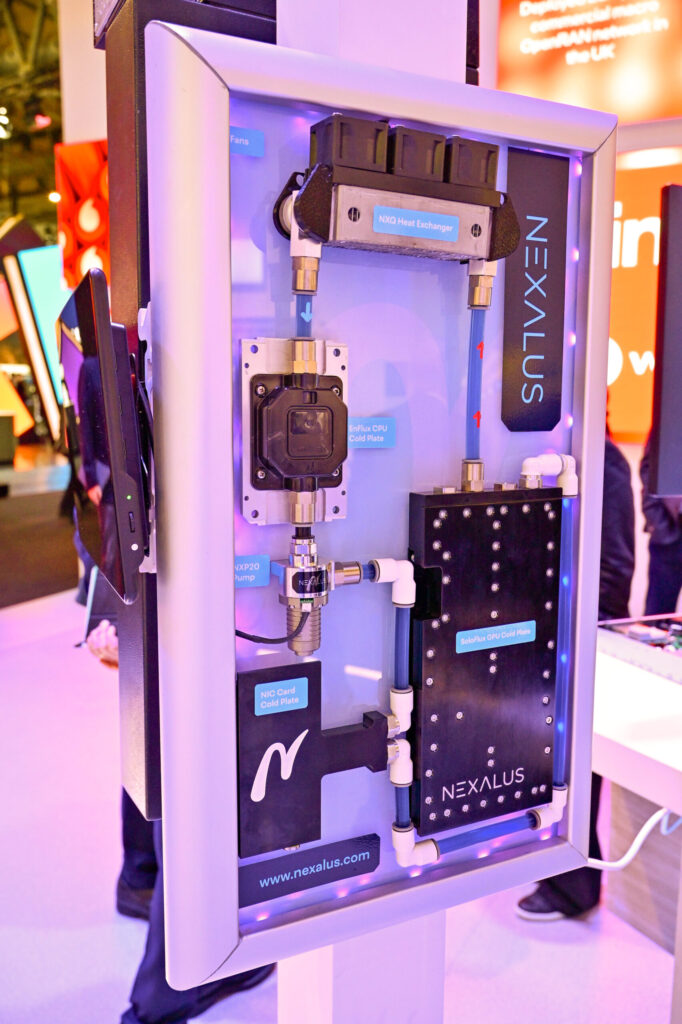ASIA ELECTRONICS INDUSTRYYOUR WINDOW TO SMART MANUFACTURING
Intel, Nexalus to Deliver Cooling Tech in Edge, Data Center
As artificial intelligence (AI) usage grows across numerous devices powering a new AI-centric era, so too does the demand for computing. Moreover, that demand takes power to run the central processing units (CPUs), graphics processing units (GPUs), and network cards.
Point in case are communications boxes that are located on telecommunications transmission towers. These towers are responsible for every cellphone call, video, text of every people’s lives.
Each of these communications boxes have GPUs, CPUs, network interface cards, and numerous other electronics and must be kept safe from extreme weather to operate efficiently.

Nonetheless, these boxes are likely to generate heat. Some 5G-based devices run at up to 81°C under full load. Without proper monitoring, that heat will degrade performance, leading to system instability and potentially trigger hazardous fires.
As a leading electronic cooling solution provider, Ireland-headquartered Nexalus has exactly what these customers need. Thus, Intel and Nexalus agreed to collaborate to ensure chips work at peak efficiency even in extreme temperatures.
A Multiyear Collaboration
Intel innovates and unveils new CPU designs for performance-hungry data centers and telecommunications customers. On the other hand, Nexalus delivers advanced cooling solutions that ensure high-performance chips operate at peak efficiency in the most rugged environments imaginable.
Therefore, the joint team from Intel and Nexalus will work collaboratively on co-engineered designs:
- Intel Flex Single-Slot GPU Block: A collaborative design that optimizes cooling and performance of GPUs.
- Next-Generation NIC Cooling Solutions: Advancing thermal management solutions for Intel’s Ethernet solutions like the Intel® Ethernet E810 Controllers and Network Adapters.
- Overclocking Intel® Xeon® CPUs: With Nexalus’ advanced cooling, customers are able to push Intel-based CPUs from 270 watts to 900 watts without any performance issues. This technology is used across industries. In Formula One racing, for example, numerous racing teams use Intel products enabled by Nexalus cooling for finite element analysis (FEA) simulations.
“Intel has spent many years deploying solutions at the network edge that has long been challenged by thermal management, power delivery and environmental factors,” explained Dirk Blevins, senior director and senior principal engineer, NEX Platform Solutions Integration, Intel.
Driving Cooling Innovations in Edge, Data Center Markets
Dr. Cathal Wilson, co-founder and chief operating officer of Nexalus said they are partnering with Intel and other leading OEMs to bring Nexalus’ cutting-edge cooling innovations to the edge and data center markets. Thus, helping drive efficiency, sustainability and performance across any industry.
Moreover, Wilson sees an untapped opportunity in these energy-hungry data centers, and that is the potential to redirect that wasted thermal energy into a sustainable heat source. Specifically, one that could keep homes warm in winter or provide hot showers to neighboring communities.

“At Nexalus, we share Intel’s commitment to innovation — specifically in thermal science and engineering. Together, we’re redefining how CPUs and GPUs consume and repurpose energy. We see a future where computing power drives not only performance but also sustainability.”
Advanced Thermal Solutions
Nexalus has collaborated with Intel to develop advanced thermal solutions that optimize efficiency and reduce costs of CPU- and GPU-based edge deployments.
These solutions feature smart heat exchangers, cold plates, and tiny microjets that quickly pump cooling liquid across the hottest parts of a CPU and GPU. Therefore, can capture over 95% of computation energy dissipated, repurposing it into hot water that can be redirected elsewhere as sustainable heat sources.
The approach is a greener, smarter alternative to today’s noisy, energy-inefficient cooling methods, like air-cooled ventilation fans.
Nexalus specifically engineered this technology for Intel’s Xeon processors. It is the result of over two years of research, design, and rapid prototyping with Intel engineers.
As Intel developed its CPU roadmap, teams shared blueprints and plans with Nexalus. That vital information, such as the specific location of computing cores that tend to generate the most heat under large workloads, helped Nexalus speed the development of its proprietary algorithms and optimize its advanced thermal solutions to target specific areas of the chip.
24 April 2025




